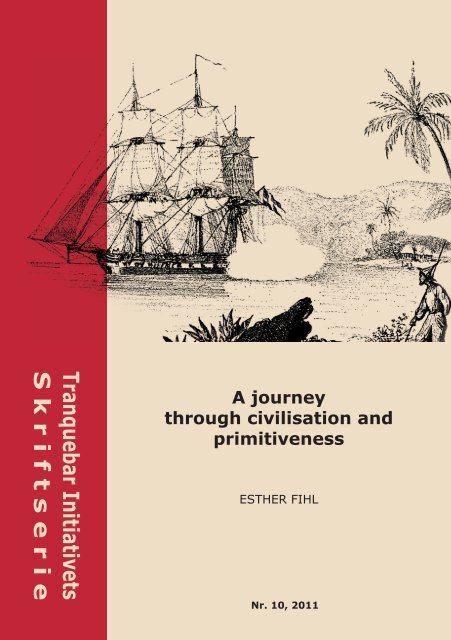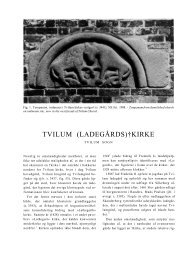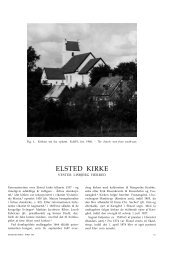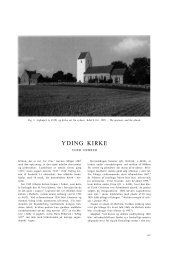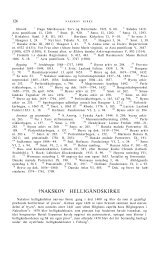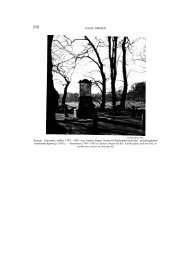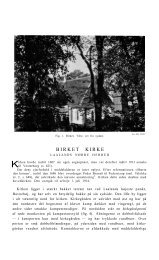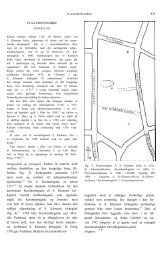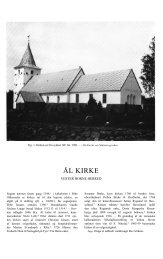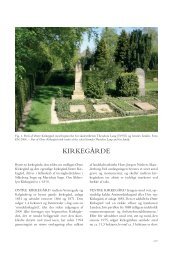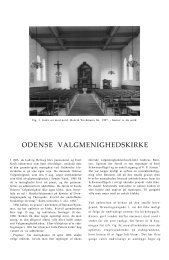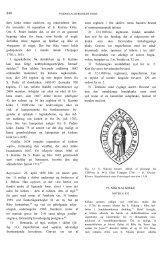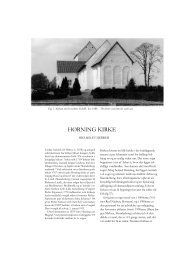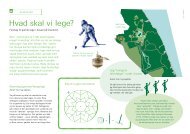Download the article "A journey through ... - Nationalmuseet
Download the article "A journey through ... - Nationalmuseet
Download the article "A journey through ... - Nationalmuseet
You also want an ePaper? Increase the reach of your titles
YUMPU automatically turns print PDFs into web optimized ePapers that Google loves.
Tranquebar Initiativets<br />
Skriftserie<br />
A <strong>journey</strong><br />
<strong>through</strong> civilisation and<br />
primitiveness<br />
ESTHER FIHL<br />
Nr. 10, 2011
Tranquebar Initiativets Skriftserie, nr. 10, 2011<br />
© The National Museum of Denmark and Es<strong>the</strong>r Fihl, 2011<br />
The publication is a revised edition of: ”Kaptain Steen Billes rejse<br />
gennem civilisation og primitivitet”, published in: Damm, Annette<br />
& Jytte Thorndahl (eds.): Danskeren og den ædle vilde – vore<br />
forstillinger om os selv og andre folk i fortid og nutid. Hovedland,<br />
Aarhus 1987, pp. 15-23. It is published as part of <strong>the</strong> research<br />
project ”Alternative Spaces – cultural awareness and cross-cultural<br />
dialogue”, The Danish Council for Strategic Research.<br />
Publisher<br />
The Tranquebar Initiative of <strong>the</strong> National Museum of Denmark<br />
The Ethnographical Collections<br />
The National Museum<br />
Frederiksholms Kanal 12<br />
DK-1220 Copenhagen K<br />
Denmark<br />
Editor-in-chief<br />
Es<strong>the</strong>r Fihl, professor, dr.phil.<br />
Translation<br />
John Irons<br />
The publication is peer reviewed<br />
Layout<br />
Mads Emil Kjergaard, student assistant<br />
Illustrations, incl. front page<br />
From Bille, Steen: Beretning om Corvetten Gala<strong>the</strong>a´s Reise omkring<br />
Jorden i 1845, 46 og 47, vols. I-II [1849]. Ed.: Kaj Birket-<br />
Smith. Copenhagen 1930.<br />
Printed by<br />
LaserTryk.dk A/S<br />
Distribution<br />
Elektronisk form:<br />
http://www.tranquebar.info<br />
ISBN<br />
978-87-7602-168-9 (paperback)<br />
978-877602-169-6 (PDF)
Dansk resumé<br />
En rejse gennem primitivitet og civilisation<br />
I 1845 stævnede korvetten Gala<strong>the</strong>a ud fra Københavns havn<br />
på en 26 måneder lang jordomrejse. Ekspeditionens formål var<br />
at foretage videnskabelige undersøgelser og knytte handels- og<br />
venskabsaftaler med fremmede lande, især Kina. I Det Indiske<br />
Ocean havde ekspeditionen tillige officielle pligter. Danmarks<br />
højhedsret over øgruppen Nicobarerne skulle markeres, og der<br />
skulle foretages en ”videnskabelig Undersøgelse over denne<br />
Øgruppes Naturproducter og anvendelse til Dyrkning og handel.”,<br />
som det lød i den kongelige instruks fra kong Chr. VIII, og i Indien<br />
skulle de to danske kolonier, Tranquebar i det tamilske Sydindien<br />
og Frederiksnagore i Bengalen, officielt overdrages til det britiskostindiske<br />
kompagni.<br />
Denne slags storstilede og kombinerede videnskabelige og<br />
sømilitære ekspeditioner var i samtiden kendte også fra andre<br />
nationer, og en af de mest berømte er det engelske togt med<br />
skibet HMS Beagle (1831-1836), hvor Charles Darwin indsamlede<br />
materiale, der senere lagde grunden til hans skelsættende bog<br />
om arternes oprindelse.<br />
Den danske ekspedition, som er gået over i historien som første<br />
danske Gala<strong>the</strong>a ekspedition, var ledet af Kaptain Steen Bille, og<br />
ombord var godt og vel 200 personer. Blandt disse var en lille<br />
skare zoologer, botanikere, geografer med deres assistenter og<br />
udpeget af Videnskabernes Selskab. Om bord var ligeledes et par<br />
tegnere, som skulle assistere videnskabsfolkene med at registrere<br />
og afbilde planter, dyr og genstande fra fremmede egne samt<br />
gengive stemninger fra opholdet blandt de forskellige folkeslag,<br />
som ekspeditionen besøgte undervejs.<br />
Emnet for Es<strong>the</strong>r Fihls publikation om den første danske<br />
Gala<strong>the</strong>a ekspedition er, hvorledes Steen Bille i sin rejseskildring<br />
opregnede forskelle og ligheder mellem de fremmede folk, som<br />
han stiftede bekendtskab med under jordomsejlingen. Billes rejseskildring<br />
med dens historisk-konkrete typologisering af den kulturelle<br />
anderledeshed, som europæerne mødte i det fremmede,<br />
kan læses som et konkret eksempel på 1800-tallets evolutionære<br />
betragtningsmåde, hvor man opregnede forskelle og ligheder mellem<br />
europæerne og de fremmede kulturer, inddelte samfundene<br />
i mere eller mindre såkaldt primitive eller civiliserede stadier og<br />
placerede dem på en liniær rangstige med det vestlige samfund<br />
i toppen.
Tranquebar Initiativet<br />
In 1845, <strong>the</strong> corvette Gala<strong>the</strong>a left Copenhagen’s harbor for<br />
a 26-month circumnavigation of <strong>the</strong> globe, <strong>the</strong> first of its kind<br />
equipped and organised from Denmark. The purpose was to conduct<br />
scientific studies and to secure Danish trade relations and<br />
friendship agreements with foreign countries, especially China.<br />
This kind of large-scale and combined scientific and naval expeditions<br />
had also been conducted by o<strong>the</strong>r contemporary nations,<br />
and one of <strong>the</strong> most famous is <strong>the</strong> British Beagle expedition<br />
(1831-1836), where Charles Darwin ga<strong>the</strong>red some of <strong>the</strong> evidence<br />
for his seminal book on <strong>the</strong> origin of species.<br />
In <strong>the</strong> Indian Ocean, <strong>the</strong> Danish expedition had important official<br />
duties. Denmark’s sovereignty over <strong>the</strong> Nicobar Islands was to<br />
be re-claimed and <strong>the</strong>re should be a “scientific study of this group<br />
of islands’ natural products and use for cultivation and trade” as<br />
it was stated in <strong>the</strong> royal instructions from King Christian VIII. In<br />
India, <strong>the</strong> two Danish colonies, Tranquebar in <strong>the</strong> Tamil part of<br />
South India and Frederiksnagore in Bengal, were to be officially<br />
handed over to <strong>the</strong> British East India Company.<br />
The voyage came to be known as <strong>the</strong> first Gala<strong>the</strong>a expedition.<br />
It was led by Captain Steen Bille, and on board were well over 200<br />
people. Among <strong>the</strong>se were a small group of zoologists, botanists,<br />
geographers with <strong>the</strong>ir assistants and nominated by <strong>the</strong> Danish<br />
Royal Academy of Sciences. On board were also a few artists who<br />
should assist <strong>the</strong> scientists to register and depict plants, animals<br />
and objects from <strong>the</strong> visited areas as well as try to capture artistically<br />
<strong>the</strong> atmosphere among <strong>the</strong> various peoples that <strong>the</strong> expedition<br />
visited en route.<br />
The object of Es<strong>the</strong>r Fihl’s publication is Steen Bille’s travelogue<br />
from <strong>the</strong> expedition and how he enumerated differences<br />
and similarities among <strong>the</strong> different people he encountered during<br />
<strong>the</strong> circumnavigation of <strong>the</strong> globe. In his travel account he<br />
presents a historically-specific typology of <strong>the</strong> cultural o<strong>the</strong>rness<br />
he identified. His portrayal can be read as a concrete example of<br />
<strong>the</strong> 1800-century evolutionary world view. In his account he listed<br />
differences and similarities among <strong>the</strong> Europeans and <strong>the</strong> foreign<br />
peoples and he divided <strong>the</strong> different cultures into more or less<br />
primitive and civilised stages which he placed on a linear social<br />
ladder with <strong>the</strong> Western civilisation at <strong>the</strong> top.<br />
Tranquebar Initiativets<br />
Skriftserie
A <strong>journey</strong> <strong>through</strong> civilisation<br />
and primitiveness<br />
ESTHER FIHL<br />
Professor, dr.phil.,<br />
The Tranquebar Initiative of <strong>the</strong> Danish National Museum<br />
and<br />
Department of Cross-Cultural and Regional Studies University of Copenhagen<br />
Tranquebar Initiativets Skriftserie, nr. 10, 2011
Introduction<br />
2<br />
ESTHER FIHL<br />
In comparison with o<strong>the</strong>r nations, Denmark has a fairly long tradition of<br />
intermittently sending out large-scale scientific expeditions to remote parts<br />
of <strong>the</strong> world with research teams of scientists, humanists and various types<br />
of artists to study <strong>the</strong> nature and culture of unknown countries. 1<br />
Scarcely 100 years after Carsten Niebuhr had returned from a <strong>journey</strong> to<br />
Arabia Felix (lit. ‘Happy Arabia’) as <strong>the</strong> sole surviving member, yet ano<strong>the</strong>r<br />
major Danish expedition was organised in 1845 that from <strong>the</strong> very outset<br />
was surrounded by at least as many expectations – and considerable prestige<br />
– as this former so tragic but epoch-making expedition. 2<br />
This time, <strong>the</strong> plan was no less than to circumnavigate <strong>the</strong> globe. For this<br />
purpose, <strong>the</strong> corvette ‘Gala<strong>the</strong>a’ was chosen – <strong>the</strong> name often subsequently<br />
used to refer to <strong>the</strong> expedition itself, which lasted from 1845-1847. 3 The<br />
aim of <strong>the</strong> voyage was both commercial and scientific. In addition, <strong>the</strong>re<br />
were various official state assignments, including attempts to establish colonies.<br />
4<br />
On <strong>the</strong> Nicobar Islands, a small group of islands in <strong>the</strong> Indian Ocean,<br />
those on board were to initiate a more comprehensive colonisation than<br />
that which had characterised earlier Danish attempts. 5 The possibilities of<br />
taking over Bali and Lombok in Indonesia were to be investigated more closely,<br />
and Danish trade was to be promoted in various ports in <strong>the</strong> Far East<br />
by <strong>the</strong> conclusion of treaties and <strong>the</strong> appointment of consuls. In India, <strong>the</strong><br />
official assignment of <strong>the</strong> expedition was to be responsible for <strong>the</strong> handing<br />
over of <strong>the</strong> Danish possessions in Tranquebar and Serampore after <strong>the</strong>ir<br />
sale to <strong>the</strong> British. During <strong>the</strong> <strong>journey</strong>, ethnographical accounts were also<br />
1 Expeditions to <strong>the</strong> Arctic comprise a larger number of <strong>the</strong>se. For <strong>the</strong> Danish expedition<br />
history, see Fihl 2010: 78-108.<br />
2 For a description of <strong>the</strong> expedition 1761-1767 to Arabia Felix, see Niebuhr 2004.<br />
3 The expedition is later known as Gala<strong>the</strong>a 1 expedition. It was followed in 1950-1952<br />
by Gala<strong>the</strong>a 2 (Wolff 2005; Nielsen 2009) and in 2006-2007 by Gala<strong>the</strong>a 3 ( Jørgensen<br />
2008).<br />
4 This kind of large-scale and combined scientific and naval expeditions had also been<br />
conducted by o<strong>the</strong>r contemporary nations, and one of <strong>the</strong> most famous is <strong>the</strong> British<br />
Beagle expedition (1831-1836), where Charles Darwin ga<strong>the</strong>red some of <strong>the</strong> evidence<br />
for his seminal book on <strong>the</strong> origin of species.<br />
5 For failed Danish attempts to colonise <strong>the</strong> Nicobar Islands and to christianise its<br />
population, see Larsen 1907; Rasch 1966; Struwe 1967; Ruhland 2006; Weihe 2006.
A <strong>journey</strong> <strong>through</strong> civilisation and primitiveness<br />
to be kept as well as collections<br />
of item to be taken home to<br />
<strong>the</strong> Ethnographical Museum in<br />
Copenhagen. Also descriptions<br />
of <strong>the</strong> natural conditions of <strong>the</strong><br />
various localities and a series of<br />
hydrographical measurements<br />
were to be made. 6<br />
It fell to Captain Steen Bille’s<br />
lot to lead this multifarious expedition.<br />
In <strong>the</strong> preceding years,<br />
he had made a career for himself<br />
within military shipping and<br />
court service. Useful experiences<br />
from sailing on <strong>the</strong> seven<br />
seas and from foreign diplomacy<br />
had been gained during his<br />
former service in <strong>the</strong> French<br />
fleet and on various Danish<br />
voyages to <strong>the</strong> West Indies and<br />
South America.<br />
With copious collections of nature-historical and ethnographic artefacts<br />
in its hold, <strong>the</strong> Gala<strong>the</strong>a returned to Denmark in 1847. Shortly afterwards,<br />
Steen Bille’s account of <strong>the</strong> expedition of <strong>the</strong> Corvette ‘Gala<strong>the</strong>a’ around<br />
<strong>the</strong> World appeared in 1849–51. 7 The work was in three volumes and compiled<br />
in such a way that it is possible to follow <strong>the</strong> expedition day by day –<br />
almost hour by hour. The route went from Copenhagen, round <strong>the</strong> Cape of<br />
Good Hope to India, continuing via South East Asia and <strong>the</strong> Pacific Islands<br />
to South America, and returning across <strong>the</strong> Atlantic.<br />
Steen Bille’s travel account is interesting from a historical mentality perspective,<br />
since <strong>the</strong> way he perceives <strong>the</strong> various different peoples encounte-<br />
6 For descriptions of <strong>the</strong> ethnographical items brought back to Denmark, see Lundbæk<br />
1992; Lillelund 2009.<br />
7 In 1930, Bille’s account was re-published by <strong>the</strong> ethnographer Kaj Birket-Smith in a<br />
shorter edition. All citations in <strong>the</strong> following have been translated from <strong>the</strong> 1930 edition.<br />
For fur<strong>the</strong>r publications on <strong>the</strong> Gala<strong>the</strong>a 1 expedition, see also Thorman (1852)<br />
and Koustrup (2006).<br />
3<br />
“A shop in Serampore.” (From Steen<br />
Bille’s travel account, vol. I, p. 65).
4<br />
ESTHER FIHL<br />
red during <strong>the</strong> voyage is a clear example of <strong>the</strong> evolutionary cultural viewpoint<br />
of his age. In his descriptions, he implicitly places <strong>the</strong> foreign peoples<br />
and that of his own on a hierarchical scale, with civilisation at <strong>the</strong> top end,<br />
and primitiveness at <strong>the</strong> lower end. 8<br />
The bearers of civilisation<br />
Bille sees clear manifestations of civilisation in <strong>the</strong> European quarter of <strong>the</strong><br />
capital city of <strong>the</strong> Anglo-Indian Empire, Calcutta. The finely laid-out city,<br />
<strong>the</strong> magnificent buildings and <strong>the</strong> well-organised conditions appeal to him:<br />
“The quarter behind Government House is <strong>the</strong> most beautiful part of<br />
<strong>the</strong> city itself, with very large, well-constructed squares, invigorated by<br />
lovely, walled water tanks, <strong>the</strong> green banks of which are most pleasing to<br />
<strong>the</strong> eye.” (Bille, vol. I, p. 60). 9<br />
When Bille reaches Tranquebar, <strong>the</strong> oldest Danish trading station in India,<br />
<strong>the</strong>re is, however, something sad in his descriptions of <strong>the</strong> place. His assignment<br />
was to strike <strong>the</strong> Danish colours, <strong>the</strong> Dannebrog, from <strong>the</strong> mast<br />
at Fort Dansborg – <strong>the</strong> symbol of <strong>the</strong> power and presence of <strong>the</strong> Danish<br />
state in <strong>the</strong> area. For here, he finds that Denmark had carried out a civilising<br />
mission among <strong>the</strong> Indians for 225 years and “with just hand dispensed law<br />
and justice among <strong>the</strong>m”. 10 Many Indians in <strong>the</strong> colony partook in Danish<br />
activities such as an Indian soldier in Danish service, a so-called:<br />
“Pion, whose red turban and red, silver-studded shoulder belt and wea-<br />
8 For nineteenth-century evolutionism in colonial practice and social <strong>the</strong>ory, see<br />
McGee & Warms (eds.) 1996, p. 5ff; Barnard 2000, p. 27ff.<br />
9 In his account, Bille states that he has only short time for exploring <strong>the</strong> town Calcutta<br />
and its surrounding. He is busy on his official errand, on behalf of <strong>the</strong> Danish state, to<br />
prepare a re-occupation of <strong>the</strong> Nicobar Islands in order to maintain sovereignty over<br />
this group of islands. Bille justifies this as only being possible by ei<strong>the</strong>r effectively colonising<br />
or by leaving at least a military force on <strong>the</strong> islands, or on ships near to <strong>the</strong>m. By<br />
order from home, <strong>the</strong> Danish colonial government in Serampore on <strong>the</strong> Hugli River<br />
had prepared for this before Bille’s arrival by investing in a British-Indian steam warship.<br />
Bille equipped <strong>the</strong> ship with Chinese workers, since he would not risk his own<br />
Gala<strong>the</strong>a crew on this venture. Earlier attempts in <strong>the</strong> late 18th and early 19th century<br />
to make a Danish plantation colony out of <strong>the</strong> Nicobar Islands had all ended in failure<br />
because of unfamiliar diseases. Bille states: “On no condition I would provide my own<br />
crew; it would have been <strong>the</strong> same as voluntarily giving <strong>the</strong>m over to sickness and death”<br />
(Bille 1930, vol. I, p. 59).<br />
10 For Tranquebar, see Fihl and Ventakachalapathy 2009.
A <strong>journey</strong> <strong>through</strong> civilisation and primitiveness<br />
pon belt bore witness to <strong>the</strong> fact that he was a royal official, also forming<br />
a striking contrast to <strong>the</strong> rest of his snow-white uniform and lending his<br />
upright figure a military air that became him extremely well.” (Bille vol.<br />
I, p. 41)<br />
Also in o<strong>the</strong>r regions of Asia, Steen Bille identifies signs of a high level of<br />
cultural development outside <strong>the</strong> area of European dominance, as with <strong>the</strong><br />
Japanese officials, who hold back Bille’s ship at sea and deny him access to<br />
<strong>the</strong> land. From <strong>the</strong> Chinese city of Canton he gives a lengthy account of <strong>the</strong><br />
relationship between his own European culture and <strong>the</strong>ir – in his eyes – somewhat<br />
reversed form of civilisation:<br />
“If a European wishes to read a Chinese book, he must open it at <strong>the</strong><br />
back, and when a Chinese person writes, he starts on <strong>the</strong> right.… As<br />
far as chairs and sofas were concerned, I once more experienced one<br />
of <strong>the</strong> amusing contrasts between Chinese and European conceptions<br />
regarding comfort and elegance. While we, especially in recent years,<br />
have found it impossible to make our sofas and armchairs soft enough,<br />
and have <strong>the</strong>refore begun to make use of elastic springs where curled<br />
horsehair stuffing and wool proved insufficient, with <strong>the</strong> less prosperous<br />
classes having to make do with hay mattresses, and only <strong>the</strong> extremely<br />
poor being obliged to sit on wooden chairs and benches, <strong>the</strong> Chinese<br />
have found it impossible to make <strong>the</strong>ir seating appliances hard enough,<br />
and it would seem that <strong>the</strong> insistence on hard seating increases with prosperity.”<br />
(Bille, vol. II, p. 37 and 24).<br />
Bille’s understanding of Chinese aes<strong>the</strong>tics and cosmology seems ra<strong>the</strong>r<br />
sparse and he tends in particular to notice only outer and immediately observable<br />
features of this foreign civilisation. Describing a visit to a distinguished<br />
Chinese family, Bille writes:<br />
“In none of <strong>the</strong>se rooms did I discern any consideration whatsoever of<br />
a symmetrical division or organisation of decoration. The doors were<br />
sometimes in one corner, at o<strong>the</strong>r times in ano<strong>the</strong>r, as were <strong>the</strong> windows<br />
– it is evidently not in this direction that one is to look for Chinese<br />
taste.” (Bille, vol. II, p. 23). 11<br />
11 For Danish trade on China in <strong>the</strong> late 18th and early 19 century, see Eilstrup &<br />
Boesgaard 1974; Clemmesen & Mackeprang 1980; Feldbæk & Justesen 1980.<br />
5
Street in Shanghai.<br />
(From Steen Bille’s travel account, vol. II, p. 57)<br />
“Catching oxen. (South America)”<br />
(From Steen Bille’s travel account, vol. II, p. 153)<br />
6<br />
ESTHER FIHL
A <strong>journey</strong> <strong>through</strong> civilisation and primitiveness<br />
The less civilised<br />
During his circumnavigation of <strong>the</strong> globe, Steen Bille also encounters cultures<br />
which he does not feel can measure <strong>the</strong>mselves with European civilisation<br />
as regards <strong>the</strong>ir stage of cultural development. Even so, he finds signs<br />
among such peoples of considerable ingenuity and proficiency. Childlike<br />
and superstitious elements, however, are stressed by him at various points<br />
in his account.<br />
On <strong>the</strong> west coast of South America, visits are paid to, among o<strong>the</strong>r places,<br />
Valparaiso, Cobia, <strong>the</strong> Chincha islands, Callao and Lima. Not much<br />
about <strong>the</strong> peoples here is to <strong>the</strong> author’s taste. What he characterises as <strong>the</strong>ir<br />
uncivilised nature features in his account and in particular what he perceives<br />
as common eating habits are something that Steen Bille takes exception<br />
to:<br />
“...we also wish to look more closely at <strong>the</strong> people who inhabit this country<br />
and <strong>the</strong> customs which <strong>the</strong>y observe. Regarding <strong>the</strong> latter, <strong>the</strong>re are<br />
here, as everywhere, many things that are reasonably based on a natural<br />
state of affairs, but also many things that only have <strong>the</strong>ir root in fancies<br />
and inclinations... on <strong>the</strong> o<strong>the</strong>r hand, <strong>the</strong> Chilean would seldom refrain<br />
– at least once a day – from going to a confectioner’s and, while smoking<br />
his ‘cigarillo’ and playing his game of dominoes, consuming deep<br />
plates full of ice or drinking one portion of water after <strong>the</strong> o<strong>the</strong>r. For<br />
lunch he could well devour two, three or even four water melons and for<br />
dinner he would stuff himself with ‘Cazula’ and ‘Puchero’: two dishes,<br />
both a mixture of meat, rice, potatoes, peppers, pumpkins, tomatoes,<br />
carrots, cabbage and sweet corn – and both equally little venerated by<br />
<strong>the</strong> European. The common man eats ‘Charque’, a kind of dried meat<br />
which, at least when hanging in <strong>the</strong> shops, has a most unappetising appearance;...”<br />
(Bille, vol. II, p. 153).<br />
7
8<br />
ESTHER FIHL<br />
Great attention, however, is paid in his description of <strong>the</strong>se regions to women,<br />
and he does not disguise <strong>the</strong> fact that he finds <strong>the</strong>ir outward appearance<br />
attractive – at least among a part of <strong>the</strong> population:<br />
“The commonest women here are ugly. So much more beautiful, on <strong>the</strong><br />
o<strong>the</strong>r hand, are <strong>the</strong> Chilean ladies, although it may well be that as far<br />
as some of <strong>the</strong>m are concerned it is <strong>the</strong>ir own natural grace that can<br />
be placed on beauty’s account – <strong>the</strong>ir gait and dancing are light, <strong>the</strong>ir<br />
hands and feet are small and elegant, <strong>the</strong> latter being fur<strong>the</strong>r enhanced<br />
by <strong>the</strong>ir tasteful footwear. They have if not fiery <strong>the</strong>n friendly, lively eyes<br />
and a graceful mouth around which a smile often hovers. The European<br />
is held in veneration... ... <strong>the</strong>y joke and laugh with him like children...”<br />
(Bille, vol. II, p. 153f ).<br />
One of <strong>the</strong> most interesting moments of <strong>the</strong> entire voyage, according to<br />
Steen Bille, was <strong>the</strong> stay in Java, <strong>the</strong> cornerstone of <strong>the</strong> Dutch colonial<br />
“Bailadeira– Java.” (from Portuguese: Indian temple dancer)<br />
(From Steen Bille’s travel account, vol. I, p. 153).
A <strong>journey</strong> <strong>through</strong> civilisation and primitiveness<br />
empire. Their host for <strong>the</strong> expedition was no less than <strong>the</strong> Dutch governor<br />
general. In <strong>the</strong> – relatively – cool climate of <strong>the</strong> city of Bogor (called<br />
Buytenzog by Bille) and <strong>the</strong> surrounding area, <strong>the</strong> governor organised various<br />
excursions for his visitors, also holding concerts with Javanese dancing<br />
and music. The following remarks concerning such activities can be seen<br />
as a typical expression of Steen Bille’s conception of <strong>the</strong> Javanese culture as<br />
being less civilised:<br />
“The orchestra consisted of a kind of xylophone – long, horizontally<br />
laid out metal plates – which were played with wooden sticks – and<br />
this music was accompanied by incessant drumming and by a violin<br />
with only two strings. Although far from beautiful, and exceptionally<br />
monotonous, this music was never<strong>the</strong>less far more harmonious than<br />
that presented by <strong>the</strong> Hindus on a similar occasion. The singing and<br />
dancing, on <strong>the</strong> o<strong>the</strong>r hand, were scarcely any better. Some small, ugly<br />
womenfolk, naked until below <strong>the</strong> waist, draped with many-coloured<br />
rags, with flowers in <strong>the</strong>ir hair, a fan in <strong>the</strong>ir hand, continually dragged<br />
<strong>the</strong>ir feet in lascivious movements, flinging <strong>the</strong>ir arm above <strong>the</strong>ir head<br />
and singing a nasal, squalling song.” (Bille, vol. I, p. 166).<br />
Children of nature<br />
On <strong>the</strong> Nicobar Islands and on <strong>the</strong> islands in <strong>the</strong> Pacific, <strong>the</strong> Gala<strong>the</strong>a expedition<br />
met peoples who, according to Steen Bille, possessed qualities which<br />
indicated <strong>the</strong>ir continued existence in a state of childlike innocence. As he<br />
saw it, <strong>the</strong>y still lived practically untouched by <strong>the</strong> vices that could arise<br />
from dealings with more civilised nations. For Steen Bille, however, <strong>the</strong> racial<br />
distinctiveness of <strong>the</strong>se peoples was extremely striking, something he<br />
attempted to describe and classify very closely for each area. In his time,<br />
<strong>the</strong>re was considerable discussion about <strong>the</strong> origins and inter-connections<br />
of races. Steen Bille seems to have been influenced by <strong>the</strong> <strong>the</strong>ories which<br />
postulated a connection between a given race and a given cultural level:<br />
“The inhabitants of <strong>the</strong> Nicobar Islands are not a noble race ei<strong>the</strong>r physically<br />
or mentally; although somewhat different from <strong>the</strong> o<strong>the</strong>r South<br />
East Asian peoples, <strong>the</strong>y are never<strong>the</strong>less most closely related to <strong>the</strong><br />
Malays. The colour of <strong>the</strong>ir skin is somewhat lighter than that of <strong>the</strong><br />
9
10<br />
ESTHER FIHL<br />
Hindus, considerably darker than that of <strong>the</strong> Chinese, differing from<br />
both by having a strong red-brown tinge. The back of <strong>the</strong> head is conspicuously<br />
flat, <strong>the</strong> crown of <strong>the</strong> head quite pointed and <strong>the</strong> width between<br />
<strong>the</strong> nodes of <strong>the</strong> parietal bone unusually large; <strong>the</strong> sides of <strong>the</strong> head are<br />
also very flat; <strong>the</strong> forehead is not high, but narrow, and has nei<strong>the</strong>r any<br />
particular elevation or inclination. The eyes are wide apart, <strong>the</strong> nose is<br />
flat and broad, <strong>the</strong> jaws extremely prominent. The mouth is broad and<br />
coarse with thick lips. The chin pointed; <strong>the</strong> ears are usually pierced to<br />
such an extent that <strong>the</strong>y could accommodate a cigar. Generally speaking,<br />
<strong>the</strong> beard is plucked and sparse and <strong>the</strong>re is little bodily hair. The hair on<br />
<strong>the</strong> head is always black, smooth and shiny; it is sometimes worn long,<br />
and <strong>the</strong>n frequently tied up with a piece of bast or <strong>the</strong> like, sometimes<br />
cut short, normally with one or more tufts of hair, and sometimes, especially<br />
among <strong>the</strong> women, whose ugliness exceeds anything one could<br />
possibly conceive, shaved off completely.” (Bille, vol. I, p. 96f ).<br />
These racial characteristics Steen Bille links to <strong>the</strong>ir ‘primitive’ cultural level<br />
which he ascribes to such characteristics as <strong>the</strong>ir laziness, <strong>the</strong>ir indifference<br />
and indolence. No form of social order appears to exist. Also <strong>the</strong> population<br />
of <strong>the</strong> Hawaiian islands he places at <strong>the</strong> same low level of culture, although<br />
“Children eating Poï – Hawaiian Islands”<br />
(From Steen Bille’s travel account, vol. II, p. 105).
A <strong>journey</strong> <strong>through</strong> civilisation and primitiveness<br />
here he finds that <strong>the</strong> Christian missionaries had been successful in raising<br />
<strong>the</strong> culture from what he designates as its animal-like state,<br />
”where cannibalism and human sacrifices were part of <strong>the</strong> order of <strong>the</strong><br />
day, where parents murdered <strong>the</strong>ir children, and <strong>the</strong> children, having<br />
grown up, <strong>the</strong>mselves mishandled, chased away, or – when <strong>the</strong>y were<br />
less cruel – killed <strong>the</strong>ir old, decrepit parents, where women lived in<br />
isolation and humiliation, where slavery and despotism oppressed<br />
<strong>the</strong> people, where ownership was dubious and personal safety simply<br />
not guaranteed, where incest was sanctioned by law, where indolence<br />
competed with drunkenness and carnal lust, and where people’s innate<br />
good nature lay smo<strong>the</strong>red beneath falsity and lies; - that <strong>the</strong>y, I say,<br />
had raised <strong>the</strong>mselves from this humiliating, almost animal-like state to<br />
a continent, upright and partially well-informed people, with a caring<br />
government and mild domestic customs.” (Bille, vol. II, p. 98).<br />
11<br />
As we have seen, Steen Bille scrupulously<br />
refers <strong>the</strong> particular<br />
characteristics of various peoples<br />
to more or less differing rungs of<br />
‘uncivilised’ cultural levels. He<br />
also manages during his <strong>journey</strong><br />
<strong>through</strong> his mental construction<br />
of civilisation and primitiveness<br />
to meet representatives of something<br />
approximating to <strong>the</strong><br />
concept of ‘<strong>the</strong> noble savage’. On<br />
<strong>the</strong> Pacific island of Borra-Borra,<br />
close to Tahiti, he finds a population<br />
<strong>the</strong> main characteristic of<br />
which he in a sort of erotic wonder<br />
describes as being cheerfully<br />
“Primeval forest on <strong>the</strong> Nicobar<br />
Islands” (from Steen Bille’s travel<br />
account, vol. I, p. 121).
good-natured:<br />
12<br />
ESTHER FIHL<br />
“Everywhere <strong>the</strong>re was a beautiful race of people living on this island.<br />
When in <strong>the</strong> evening we strolled along <strong>the</strong> beach and saw <strong>the</strong>se womenfolk<br />
standing in <strong>the</strong>ir garden doors, or sitting in <strong>the</strong>ir canoes, which<br />
would rock gently on <strong>the</strong> gentle swell, we could not do o<strong>the</strong>rwise than<br />
to admire <strong>the</strong> beautiful physical appearance of <strong>the</strong>se children of nature,<br />
which, to be quite truthful, <strong>the</strong>y were not at any pains to conceal. A<br />
thin shirt, like that also worn by many of <strong>the</strong> men, only scantily covered<br />
<strong>the</strong>m from <strong>the</strong> hips down. Always, though, <strong>the</strong>y had fresh flowers<br />
plaited in <strong>the</strong>ir black hair, which <strong>the</strong>y knew how to arrange in a particularly<br />
becoming fashion, and in all positions <strong>the</strong>y had a certain grace<br />
which, combined with <strong>the</strong> beautiful natural scenery and <strong>the</strong> deepening<br />
twilight, with <strong>the</strong> mysterious silence that reigned over forest and sea –<br />
with <strong>the</strong>ir entire surroundings, in short – radiated what I might call an<br />
aura of beauty over <strong>the</strong>m.” (Bille, vol. II, p. 145).<br />
In Bille’s travel account of his encounter with peoples of a foreign world<br />
on his circumnavigation of <strong>the</strong> globe, he represents cultural “o<strong>the</strong>rness” in<br />
a way which illustrates <strong>the</strong> evolutionary thinking budding within social<br />
thinking in Europe at his time. The cultural differences are interpreted as<br />
evidences of a longer or shorter historical distance between <strong>the</strong> Europeans<br />
and <strong>the</strong> people of <strong>the</strong> rest of <strong>the</strong> world. In that sense Bille’s <strong>journey</strong> <strong>through</strong><br />
civilisation and primitiveness is at <strong>the</strong> same time a travel in time. The cultural<br />
o<strong>the</strong>rs were assimilated in his world view as already known steps or stages<br />
in an evolutionary development from <strong>the</strong> most primitives to <strong>the</strong> high-<br />
est civilisations.
A <strong>journey</strong> <strong>through</strong> civilisation and primitiveness<br />
Bibliography<br />
Barnard, Alan: History and Theory in Anthropology. Cambridge 2000.<br />
Bille, Steen: Beretning om Corvetten Gala<strong>the</strong>a´s Reise omkring Jorden i 1845,<br />
46 og 47, vols. I-II [1849]. Revised edition by Kaj Birket-Smith.<br />
Copenhagen 1930.<br />
Clemmesen, Tove & Mogens B. Mackeprang: Kina og Danmark 1600-1950.<br />
<strong>Nationalmuseet</strong>, Copenhagen 1980.<br />
Eilstrup, Per & Niels Eric Boesgaard: Fjernt fra Danmark. Billeder fra vore<br />
Tropekolonier, Slavehandel og Kinafart. Copenhagen 1974.<br />
Feldbæk, Ole & Ole Justesen: Kolonierne i Asien og Afrika, Copenhagen<br />
1980.<br />
Fihl, Es<strong>the</strong>r: Kaptain Steen Billes rejse gennem civilisation og primitivitet, in:<br />
Damm, Annette & Jytte Thorndahl (eds.): Danskeren og den ædle<br />
vilde – vore forstillinger om os selv og andre folk i fortid og nutid.<br />
Hovedland, Aarhus 1987, pp. 15-23.<br />
Fihl, Es<strong>the</strong>r: Exploring Central Asia. From <strong>the</strong> Steppes to <strong>the</strong> High Pamirs<br />
1896-1899, vols. I-II, University of Washington Press 2010.<br />
Fihl, Es<strong>the</strong>r & A.R. Venkatachalapathy (eds.): Cultural Encounters in<br />
Tranquebar: Past and Present, Special issue, Review of Development<br />
and Change, vol. XIV, nos. 1 & 2, 2009.<br />
Jørgensen, Lisbeth Nannested (ed.): Gala<strong>the</strong>a 3. 2006-2007, Dansk<br />
Ekspeditionsfond and Thaning & Appel, Copenhagen 2008.<br />
Koustrup, Søren: Gala<strong>the</strong>as forunderlige rejse. Forlag: Lindhardt & Ringhof<br />
2006.<br />
Larsen, Kay: Det første danske Nikobar-Foretagende 1755-60, Tidsskrift for<br />
Søvæsen, no. 78, Copenhagen 1907.<br />
Lillelund, Caroline: Lavkasternes Tranquebar. Om udfordringerne ved at repræsentere<br />
lavkasternes materielle kulturarv, Tranquebar Initiativets<br />
Skriftserie, 8, Copenhagen 2009.<br />
13
14<br />
ESTHER FIHL<br />
Lundbæk, Torben: Corvetten Gala<strong>the</strong>as indsamlinger til Ethnographisk<br />
Musæum 1845-47, <strong>Nationalmuseet</strong>s Arbejdsmark, Copenhagen<br />
1992.<br />
McGee, R. Jon & Richard L. Warms (eds.): Anthropological Theory. An<br />
Introductory History. Mayfield Publishing Compagny, London<br />
1996.<br />
Niebuhr Carsten: Travels <strong>through</strong> Arabia and O<strong>the</strong>r Countries in <strong>the</strong> East,<br />
Performed by M. Niebuhr, Now a Captain of Engineers in <strong>the</strong><br />
Service of <strong>the</strong> King of Denmark. Translated into English by<br />
Robert Heron Edinburgh: Printed for R. Morison, 1792, vols. I-II,<br />
Dinsmore Documentation, Westfield 2004.<br />
Nielsen, Kristian Hvidtfelt: På jagt efter søslangen. Gala<strong>the</strong>a-ekspeditionen<br />
1950-52, Aarhus Universitetsforlag 2009.<br />
Rasch, Aage: Dansk Ostindien 1777-1845, vol. VII in Johannes Brøndsted<br />
(ed.): Vore gamle tropekolonier, 2nd ed., Copenhagen 1967.<br />
Ruhland, Thomas: The Moravian Brethren and <strong>the</strong> Danish-Halle Mission<br />
in Tranquebar – <strong>the</strong> ‘Garden of <strong>the</strong> Bro<strong>the</strong>rs’ at <strong>the</strong> Centre of a<br />
European Conflict, in Gross, Andreas, Y. Vincent Kumaradoss<br />
and Heike Liebau (eds): Halle and <strong>the</strong> Beginning of Protestant<br />
Christianity in India, Halle 2006, vol. II. pp. 743-766.<br />
Struwe, Kamma: Dansk Ostindien 1732-1776, vol. VI in Johannes Brøndsted<br />
(ed.): Vore gamle tropekolonier, 2nd ed., Copenhagen 1966.<br />
Thorman, Christian: Skizzer optagne på Corvetten Gala<strong>the</strong>as Jordomsejling.<br />
C. W. Stincks Forlag 1852.<br />
Weihe, Hans-Jorgen Wallin: Historical encounters in <strong>the</strong> Nicobar Islands.<br />
Permafrost Press, Lillehammer 2006.<br />
Wolff, Torben: Ethnographic observations on <strong>the</strong> Nicobar Islands from <strong>the</strong><br />
Gala<strong>the</strong>a Expedition 1950-1952, Folk, vol. 46/47, Copenhagen<br />
2005.
A <strong>journey</strong> <strong>through</strong> civilisation and primitiveness<br />
About <strong>the</strong> author<br />
Es<strong>the</strong>r Fihl, Professor, dr.phil., is <strong>the</strong> research leader of <strong>the</strong> Tranquebar Initiative of <strong>the</strong><br />
National Museum of Denmark and head of Centre for Comparative Cultural Studies,<br />
Department of Cross-Cultural and Regional Studies, University of Copenhagen,<br />
Denmark. Es<strong>the</strong>r Fihl is trained in anthropology and her research area is cultural encounters.<br />
She has published extensively on Danish travel literature and expeditions. In<br />
that field her main work is Exploring Central Asia. From <strong>the</strong> Steppes to <strong>the</strong> High Pamirs,<br />
vol. I-II, University of Washington Press, 2010.<br />
15


